- Author Jason Gerald [email protected].
- Public 2024-01-19 22:11.
- Last modified 2025-01-23 12:04.
Rashes on the face can be caused by a variety of things, such as laundry detergent, face cream, food, or exposure or medications taken in the last 24-48 hours. Fortunately, these rashes will often go away on their own after a day or two. However, if the rash you experience is quite severe or does not improve, you should contact your doctor for help. Meanwhile, if you have a new rash and want to treat it yourself, there are some home remedies you might want to try.
Step
Method 1 of 3: Soothes Skin
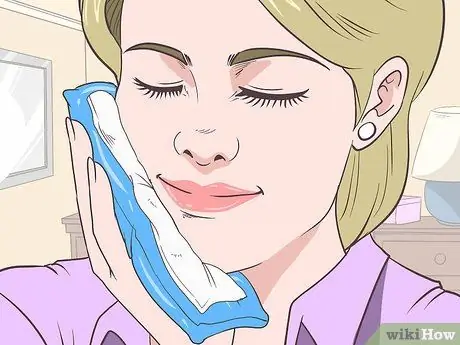
Step 1. Use a cold compress
Compressing your face can help relieve itching as well as soothe the rash. To compress the face, wet a clean cotton washcloth with cold water until saturated. Then, wring out the washcloth and apply it on your face. If the rash is on only one part of your face, fold the washcloth and just apply it to that area.
- Repeat this treatment throughout the day as needed.
- Don't let other people use the same washcloth just in case your rash can spread.
- Hot temperatures can make rashes and skin irritation worse. So, only use cold water which can reduce inflammation.
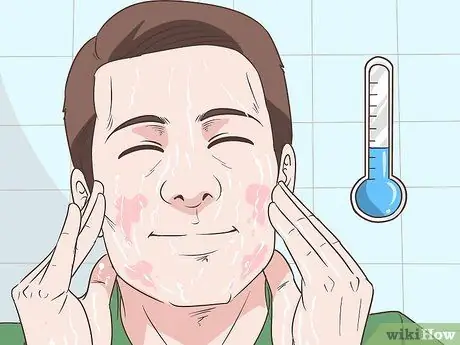
Step 2. Wash your face with cold water
Splashing cold water on your face may also help soothe the rash. Prepare fairly cold water, but not ice water. Then bring your face close to the water container and while closing your eyes, splash the water several times towards your face. Pat your face with a dry, clean towel when you're done.
- Repeat this treatment throughout the day as needed.
- You may also need to use a small amount of a gentle cleansing product to remove any remaining makeup or other products that may be causing the rash. Pay close attention to the products you've started using recently.
- Don't rub your face. Rubbing your face can cause the rash to expand and get worse.

Step 3. Don't use makeup or other facial care products for a few days
To make sure that the cause of the rash is not cosmetics or other products, you may need to stop using makeup, creams, lotions, serums, or other chemicals until the rash improves.
Use a gentle cleansing product like Cetaphil, or just use water to clean your face for a few days. Do not use moisturizer or other products after cleansing your face
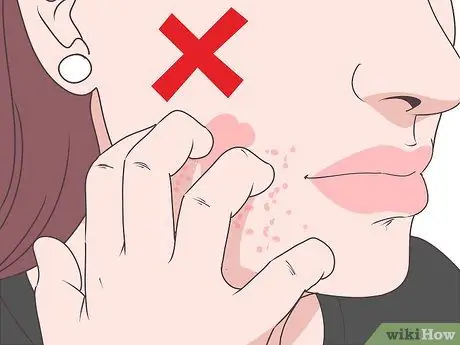
Step 4. Try not to touch or scratch your face
Touching or scratching can make the rash worse and increase the chances of transmission (if it's contagious). Keep your hands away from your face and do not rub or scratch your face with other objects.
Method 2 of 3: Using Natural Treatments

Step 1. Apply a little hemp seed oil
Hemp seed oil can relieve itching and help moisturize dry rashes. Pour a few drops of hemp seed oil on your fingertips and then rub it all over your face. Do this treatment twice a day after cleansing your face.
- Try using hemp seed oil on the inside of your elbows before your face to make sure your skin doesn't react negatively, which can actually make the rash worse.
- Be sure to wash your hands after touching your face to prevent the rash from spreading.

Step 2. Use aloe vera gel
Aloe vera gel has antibacterial properties and can help soothe rashes. Try applying a thin layer of aloe vera on your face. Let the aloe vera dry on your face. Repeat this treatment several times a day.
Remember to wash your hands after applying aloe vera gel
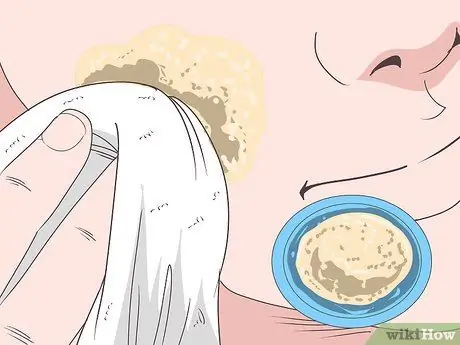
Step 3. Use colloidal oatmeal
A colloidal oatmeal bath can help soothe rashes on the body. You can also use colloidal oatmeal on your face. You can buy colloidal oatmeal at pharmacies.
- Try pouring a few tablespoons of colloidal oatmeal into a bowl of warm water. Then, dip a cotton washcloth in the solution.
- Use a washcloth to pat the colloidal oatmeal solution on your face.
- Leave the colloidal oatmeal solution on your face for a few minutes. After that, wash your face with lukewarm water.
- Repeat this treatment several times a day until your rash heals.

Step 4. Make a herbal compress
Some types of herbal plants can soothe the skin so that it can also help treat rashes on the face. To use it, try brewing a tea and using it instead of water in a cold compress treatment.
- Measure the herbs goldenseal, calendula, and echinacea as much as 1 teaspoon.
- Put this herbal plant in a mug and pour it with boiling water. Steep for about 5 minutes then strain.
- Allow the water to cool to room temperature or place in the refrigerator for about 1 hour to cool.
- Dip a clean cotton washcloth in the tea solution. Squeeze out the washcloth and apply it to your face for about 5-10 minutes.
- Repeat this treatment twice a day.
- Stop this "natural" treatment if your skin rash worsens after using it. Sometimes, the rash can get worse if something is put on it.

Step 5. Use witch hazel toner and follow up with coconut oil moisturizer
Dip a cotton ball in witch hazel. Then, wipe a wet cotton ball on your face. This rub will spread the witch hazel over the entire surface of the skin and soothe it. After that, rub coconut oil on your face to moisturize it. This moisturizer can also soothe the skin.
- You can buy witch hazel alone or buy a toner made mostly or entirely of witch hazel.
- You can find coconut oil on the cooking oil rack at the convenience store. Choose extra virgin coconut oil.
Method 3 of 3: Seeking Medical Help
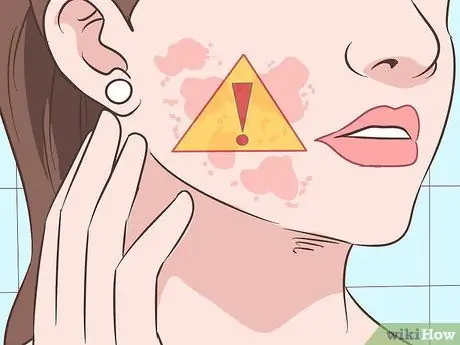
Step 1. Seek immediate medical attention for a rash accompanied by severe symptoms
In some cases, a rash may be a symptom of a severe allergic reaction that requires emergency medical attention. Call emergency services (118) if you develop a rash accompanied by:
- Shortness of breath or difficulty breathing
- Tightness in the throat and/or difficulty swallowing
- Swelling of the face
- A purplish color similar to bruising
- Bidur
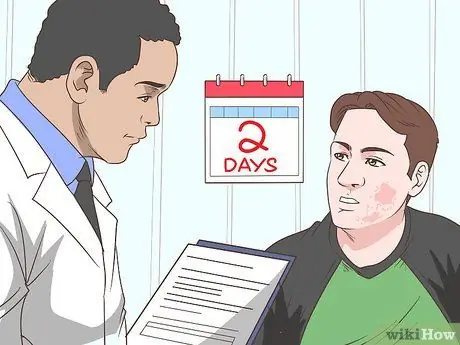
Step 2. See a doctor if the rash doesn't improve within two days
The rash often goes away on its own, but it can also be a sign of an illness that requires treatment. If the rash doesn't improve within a few days, call your doctor.
- If you are taking any new medicines or medicines, contact your doctor immediately. The rash you are experiencing may be a side effect of medication. Do not stop using the drug unless advised by your doctor or if you have severe symptoms (which require emergency treatment).
- Keep in mind that there are different types of rashes and their causes. Your doctor can help determine the cause of the rash and find the best way to treat it and prevent it from recurring in the future.

Step 3. Ask your doctor about the use of hydrocortisone cream
Hydrocortisone cream can be purchased without a prescription and may help with facial rashes. However, you should not use this cream on sensitive skin (face) without consulting your doctor first.
Cortisone cream is available in several dosage options and is recommended for short-term use because it can thin the surface of the skin
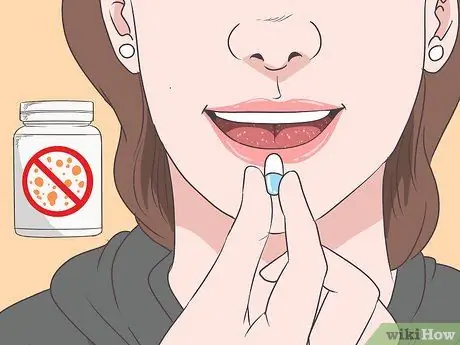
Step 4. Use an antihistamine
Some types of rash may be caused by allergies. So taking an antihistamine might help. Consult with your doctor first to determine if taking an antihistamine can help with your rash. If the rash is itchy, consider taking an antihistamine, such as:
- Fexofenadine (Allegra)
- Loratadine (Claritin)
- Diphenhydramine (Benadryl)
- Cetirizine dihydrochloride (Ozen)
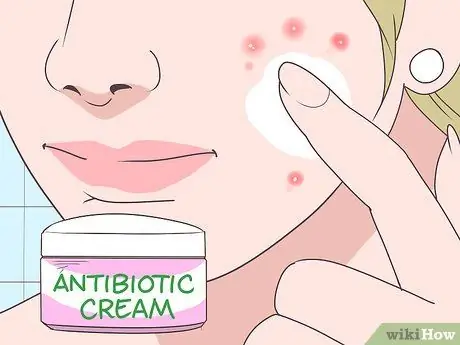
Step 5. Use an antibiotic cream
Some types of rash may be accompanied by acne filled with pus and infected. If your rash looks like a purulent pimple, you may want to consider using an antibiotic cream. Consult with your doctor first to make sure this option is right. Also make sure to read and follow the instructions for using the drug.
- Your doctor may prescribe an antibiotic cream such as mupirocin (Bactroban) to treat severe skin infections.
- Remember that there are no topical creams or ointments to treat viral rashes. The rash seems to be going away on its own.
- Fungal rashes can also be treated with a topical cream containing clotrimazole (Lotrimin). Your doctor can tell if your rash is caused by a fungus.






